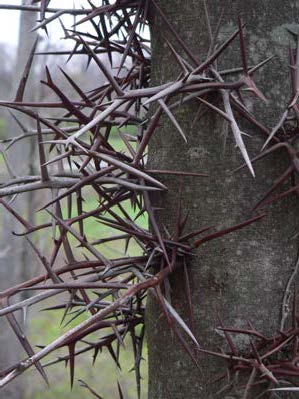AgEBB-MU CAFNR Extension
Green Horizons
Volume 23, Number 1
Winter 2019
Agroforestry
Species Spotlight: Honeylocust
By Mike Gold | Interim Director, Center for Agroforestry
Well known as an ornamental street and yard tree, honeylocust, (Gleditsia triacanthos L.), grows naturally in the eastern half of the United States. It has become naturalized east of the Appalachian Mountains from Georgia to New England in the East, and north to South Dakota in the West. In its natural habitat, honeylocust is a minor component in riverine forest associations in the eastern United States.
Ornamental. Because is it resistant to both drought and salinity, compact, poorly aerated soils and tolerates flooding, horticultural selections of thornless honeylocust (Gleditsia triacanthos var. inermis) have been widely planted as an ornamental in parking lots; highway medians; lawn specimen trees; and residential street trees. The tree has been successfully grown in urban areas where air pollution, poor drainage, compacted soil, and/ or drought are common in the United States and Canada with over fifty recognized cultivars. Honeylocust has small, pinnately compound leaves and casts a light shade that permits excellent grass (forage) growth underneath the tree.
 |
Honeylocust silvopasture at Virginia Tech, Blacksburg, VA |
Botany. Gleditsia triacanthos L., family Leguminosae (subfamily Caesalpinioideae), are typically 45-75' feet in height and 1.5 - 3.0 feet in diameter (maximum height 150 feet, diameter 6 ft). Ornamental trees often have a short bole and open, narrow or spreading crown with reddish brown to black scaly ridged bark. Wild trees are often covered in clusters of large, branched thorns. Leaves are 4-8" long, deciduous, pinnate or bi-pinnate with 15-30 leaflets, "1/2 - 1" long. Mature pods, 6-15" long, begin to fall by mid-September and continue to drop throughout the winter.
Wood Quality. The wood of honeylocust is strong, hard and durable, resistant to shock, with attractive figure and reddish-brown color, it is used locally for fence posts, pallets, crating, general construction, railroad ties and by woodworkers for making guitars. Wood specific gravity is 0.60 green, 0.67 oven dry and is considered an excellent source of fuelwood.
 |
|
Thorny Nightmare? Useful Tree for Silvopasture and Animal Fodder ? Both.
In addition to its widespread use as an ornamental, honeylocust is also widely known to rural America as a nasty, thorny, nightmare. The multi-branched woody thorns of honeylocust (actually modified branches) can cover the trunk and branches in a formidable sheath of hardened spines. As such, when wild honeylocust invades open pastures, it is rightly rightly viewed by most as a nuisance to be cut and removed. Thorns on mature trees (twigs, branches and bark) are extremely dangerous as they can puncture tractor tires and heavy duty boots. Volunteer reproduction of thorny seedlings, usually derived from seeds eaten and not digested by wild and domestic animals, is also a concern.
Silvopasture Agroforestry. Promoted in J. Russell Smith's Tree Crops: A Permanent Agriculture (1929) honeylocust was widely advocated as a supplemental livestock feed (edible pods) early in the 20th century. A search for heavy-bearing honeylocust selections lead to silvopastoral cultivar development in the 1930's at the Tennessee Valley Authority and at Auburn Alabama resulting in named cultivars including 'Millwood' and 'Calhoun' selected for their large and heavy pod production. Mature pods begin to drop by mid- September and continue to drop throughout the winter.
Silvopasture Establishment. Due to large variation in pod production from different parent trees, and the presence of both male and female trees, only grafted seedlings are recommended for planting in order to secure consistently high production at an early age. Grafted trees will eventually produce from 40-150 lbs of pods (dry weight) per tree biennially. Of interest for silvopasture, honeylocust thorns are a juvenile wood trait and the upper branches of a thorny honeylocust are thornless. You can take grafts from thornless upper branches and graft them to honeylocust seedling rootstock to obtain a phenotypically thornless, heavy pod-bearing tree for use in silvopasture. Again a caution: If the seedlings derived from the pods of these grafted trees are allowed to grow up in the pastures, they will be thorny, but if constantly grazed in a managed intensive grazing silvopasture system, they will not become an issue.
 |
|
Honeylocust pods have long been recognized for their animal fodder value in silvopastoral systems. Widely spaced overstory fodder trees can be planted for on-farm silvopastoral systems, providing light shade, soil enrichment and stabilization, and are compatible with a variety of understory forages. In addition to yields from understory forage and provision of shade for livestock during the summer, the pods function primarily as a late fall/winter animal feed supplement.
Windbreaks. Honeylocust is hardy and drought tolerant, and can be grown in windbreaks with the added benefit of pod production.
